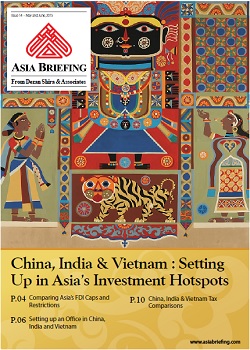China, India & Vietnam: Setting Up in Asia’s Investment Hotspots – New Issue of Asia Briefing Magazine
 The newest issue of Asia Briefing magazine, titled “China, India & Vietnam – Setting Up in Asia’s Investment Hotspots“, is out now and available as a complimentary download in the Asia Briefing Bookstore.
The newest issue of Asia Briefing magazine, titled “China, India & Vietnam – Setting Up in Asia’s Investment Hotspots“, is out now and available as a complimentary download in the Asia Briefing Bookstore.
Contents:
- Comparing Asia’s FDI Caps and Restrictions
- Setting up an Office in China, India and Vietnam
- China, India & Vietnam Tax Comparisons
Since China’s economic reforms in the late 1970s, Asia’s investment landscape has changed. World Trade Organization rules and the advent of a fair global trading system have undoubtedly contributed to this, as have regional trade blocs such as the ten-country Association of Southeast Asian Nations (ASEAN).
These developments have enabled Asia’s place within global trade to become more pronounced. Part of this is driven by demographics, as large numbers of relatively low-cost workers come into the labor pool and can assist with manufacturing competitive products, both for the local Asian and overseas markets. Coupled with this is the region’s growing middle class, which creates a consumer dynamic that is attractive for foreign investment. As a result, there are now numerous locations in Asia where a foreign entity can run a successful business.
In this issue of Asia Briefing Magazine, we have set out to produce a guide to investing and establishing a business in Asia, focusing on the markets of China, India and Vietnam. We begin by analyzing how investment is treated in specific industries across these three countries. We then take a look at the investment vehicles that a foreign business can select, with an emphasis on representative offices (ROs) and liaison offices (LOs). Finally, we highlight the various forms of taxation that a foreign company should be aware of when entering the Asian market.
With our experience across Asia, Dezan Shira & Associates is well positioned to help foreign businesses expand their operations to anywhere in the region. We hope that this issue can serve as a good starting point.
|
Asia Briefing Ltd. is a subsidiary of Dezan Shira & Associates. Dezan Shira is a specialist foreign direct investment practice, providing corporate establishment, business advisory, tax advisory and compliance, accounting, payroll, due diligence and financial review services to multinationals investing in China, Hong Kong, India, Vietnam, Singapore and the rest of ASEAN. For further information, please email asia@dezshira.com or visit www.dezshira.com. Stay up to date with the latest business and investment trends in Asia by subscribing to our complimentary update service featuring news, commentary and regulatory insight.
|
![]()
The 2015 Asia Tax Comparator
In this issue, we compare and contrast the most relevant tax laws applicable for businesses with a presence in Asia. We analyze the different tax rates of 13 jurisdictions in the region, including India, China, Hong Kong, and the 10 member states of ASEAN. We also take a look at some of the most important compliance issues that businesses should be aware of, and conclude by discussing tax and finance concerns companies will face when entering Asia.
 The Asia Sourcing Guide 2015
The Asia Sourcing Guide 2015
In this issue of Asia Briefing, we explain how and why the Asian sourcing market is changing, compare wage overheads, and look at where certain types of products are being manufactured and exported. We discuss the impact of ASEAN’s FTAs with China and India, and highlight the options available for establishing a sourcing model in three locations: Vietnam, China, and India. Finally, we examine quality control in each of these markets.
 Manufacturing Hubs Across Emerging Asia
Manufacturing Hubs Across Emerging Asia
In this issue of Asia Briefing Magazine, we explore several of the region’s most competitive and promising manufacturing locales including India, Indonesia, Malaysia, Singapore, Thailand and Vietnam. Exploring a wide variety of factors such as key industries, investment regulations, and labor, shipping, and operational costs, we delineate the cost competitiveness and ease of investment in each.
- Previous Article China Regulatory Brief: Reduced Import Tariffs and China-Chile Free Trade Agreement
- Next Article Going Organic: Investing in China’s Growing Health Foods Market




























